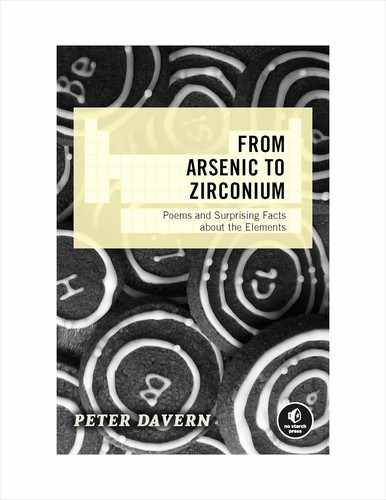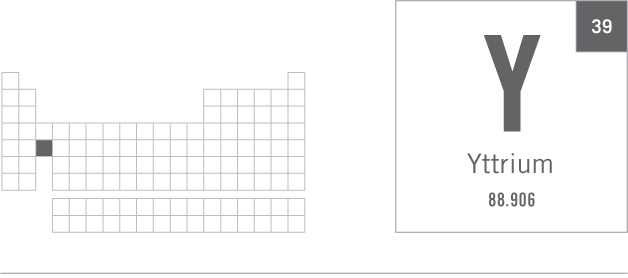YTTRIUM, Y
THE FIRST OF FOUR
it-ree-ums
“Rare” yttrium’s the first of four from Ytterby’s ol’ seams,
GROUP 3 TRANSITION METAL
Yttrium (pronounced it-ree-um) is formally included among the rare-earth elements but isn’t particularly rare; in fact, it’s more abundant than silver and lead. But its chemical properties are similar to rare-earths, and it tends to exist alongside them in minerals. You could, perhaps, think of yttrium as a rare-earth “wannabe” or “groupie”! See “Scandium, Sc” on page 60 for more on the rare earths.
Yttrium was discovered as yttrium oxide (Y2O3) in a coal-like mineral from an old quarry seam near the small Swedish village of Ytterby, located on an island in the Stockholm archipelago. Three more rare-earth elements hidden within the oxide were subsequently discovered and were also named in honor of their Swedish “birthplace”: erbium (Er), terbium (Tb), and ytterbium (Yb).
yag (rhymes with “rag”)
Its YAG (when dop’d in solid-state) shoots über-laser beams.
Crystals of yttrium aluminum garnet (YAG) doped with neodymium provide the solid-state laser source for a class of high-powered lasers capable of cutting and drilling through metals.
Its oxide quells hot shocks in glass,
Yttrium oxide (Y2O3) helps to improve the heat- and shock-resistance of glass.
Its “1-2-3” conducts—top-class!
When the mixed oxide that yttrium forms with barium and copper is cooled with liquid nitrogen to –196°C, it displays superconducting properties (that is, it conducts electricity without losing energy). It’s better known by its abbreviated names 1-2-3 and YBCO, which are derived from its formula, YBa2Cu3O7–9.
why-ninety’s
Short-liv’d Y-90’s “beta bits” thwart cancer’s evil schemes.
Yttrium has only one naturally occurring isotope, yttrium-89. But a radioactive isotope, yttrium-90, is formed when strontium-90 decays radioactively (with potentially serious consequences—see “Strontium, Sr” on page 111). 90Y undergoes a similar radioactive beta decay. In this process, the transformation of one of 90Y’s neutrons to a proton is accompanied by the emission of a high-speed electron, also known as a beta particle. Due to 90Y’s relatively short half-life of approximately 64 hours, its beta particles have been harnessed in a controlled manner to treat various cancers by landing “radioactive knockout punches” on cancerous cells.


